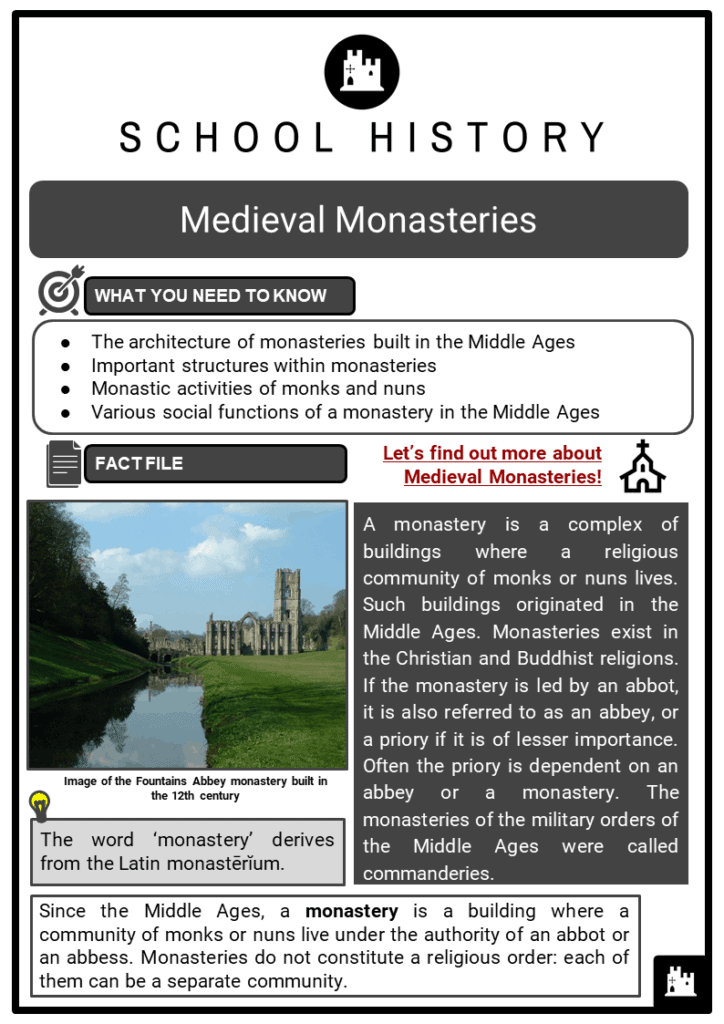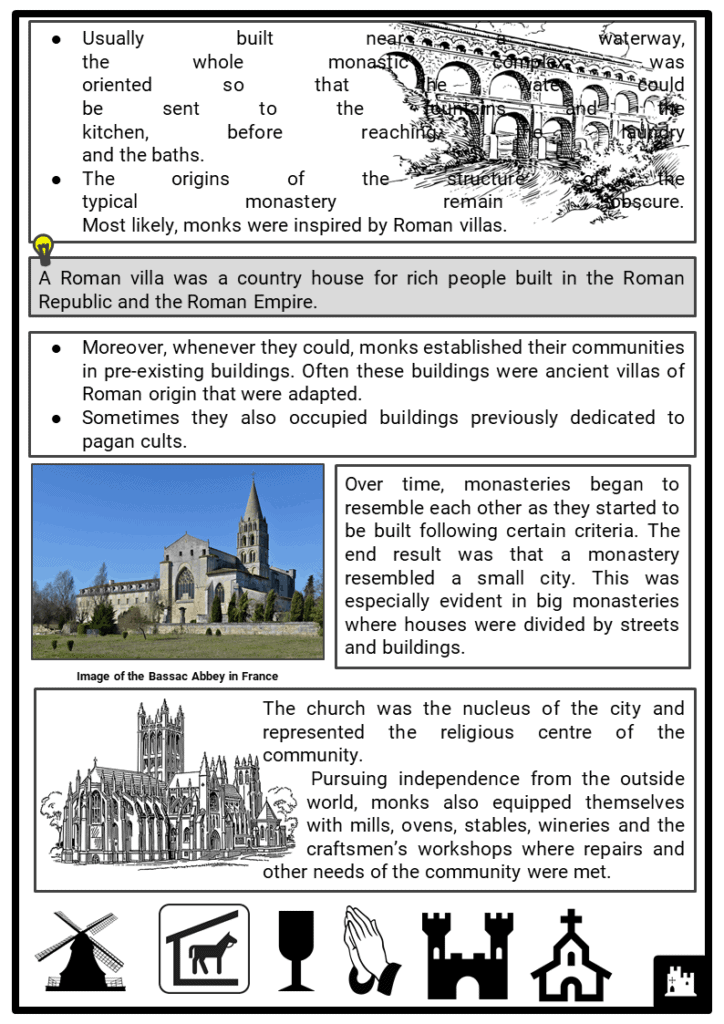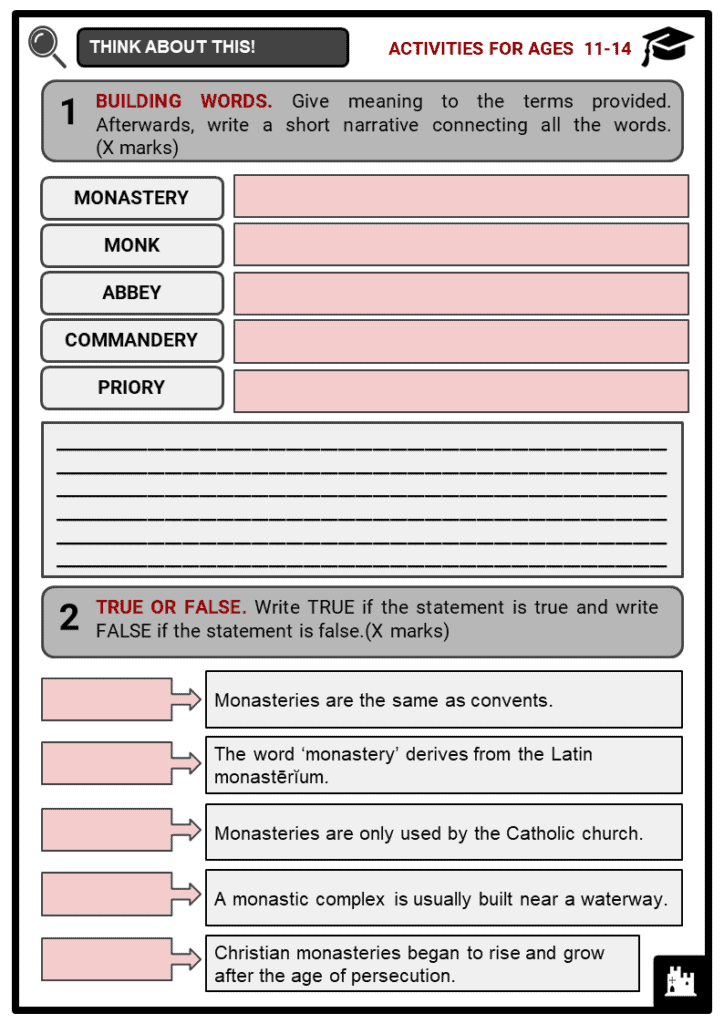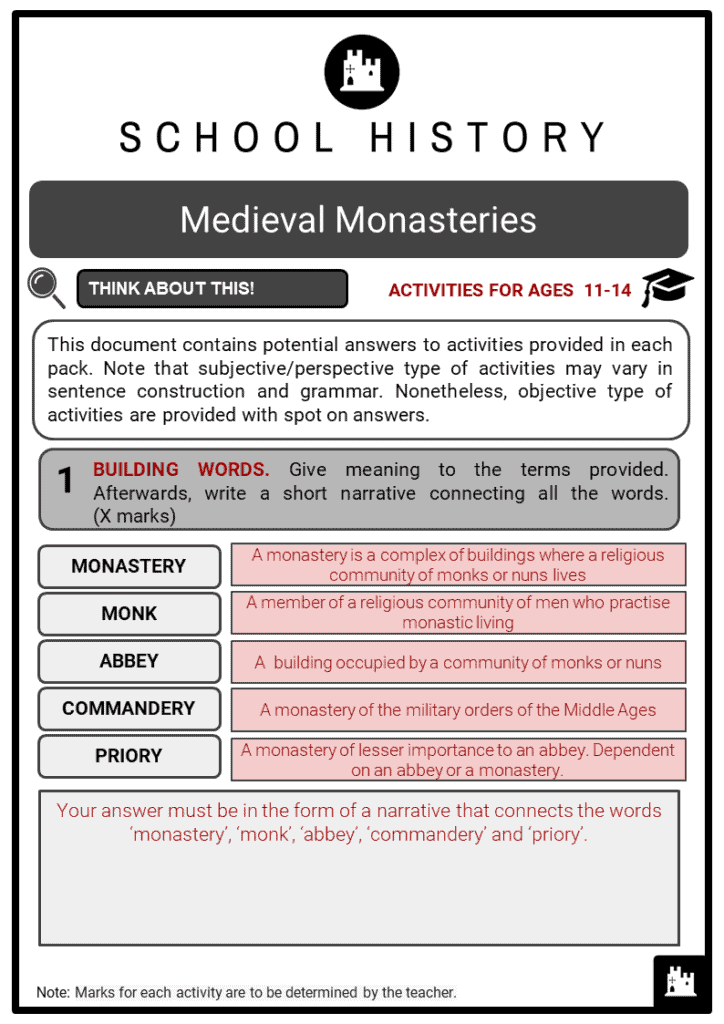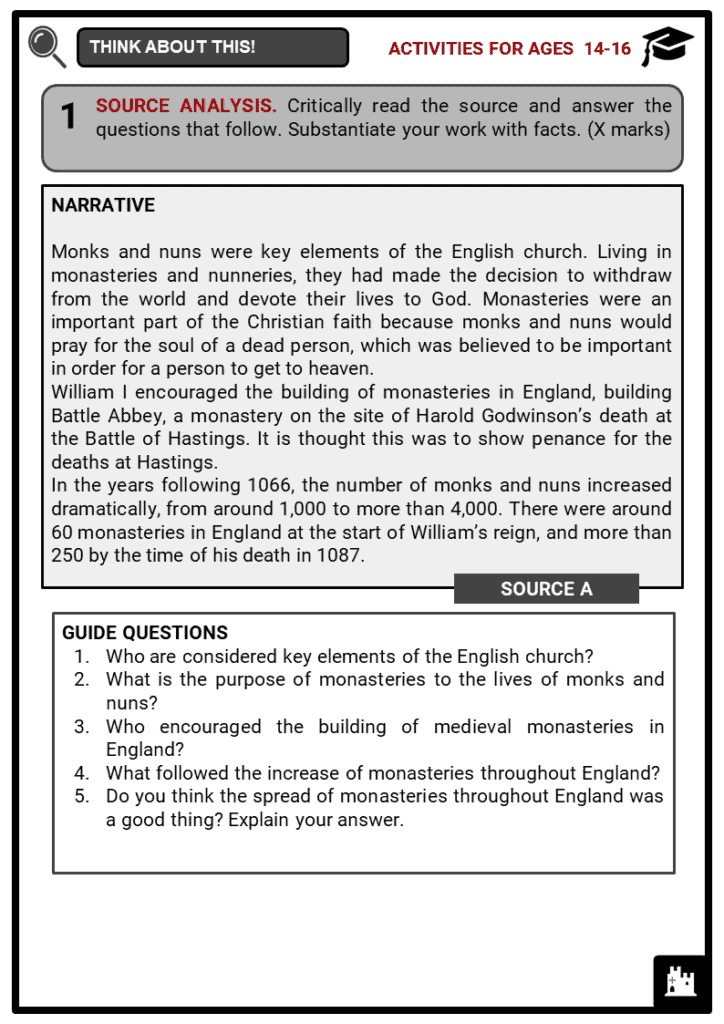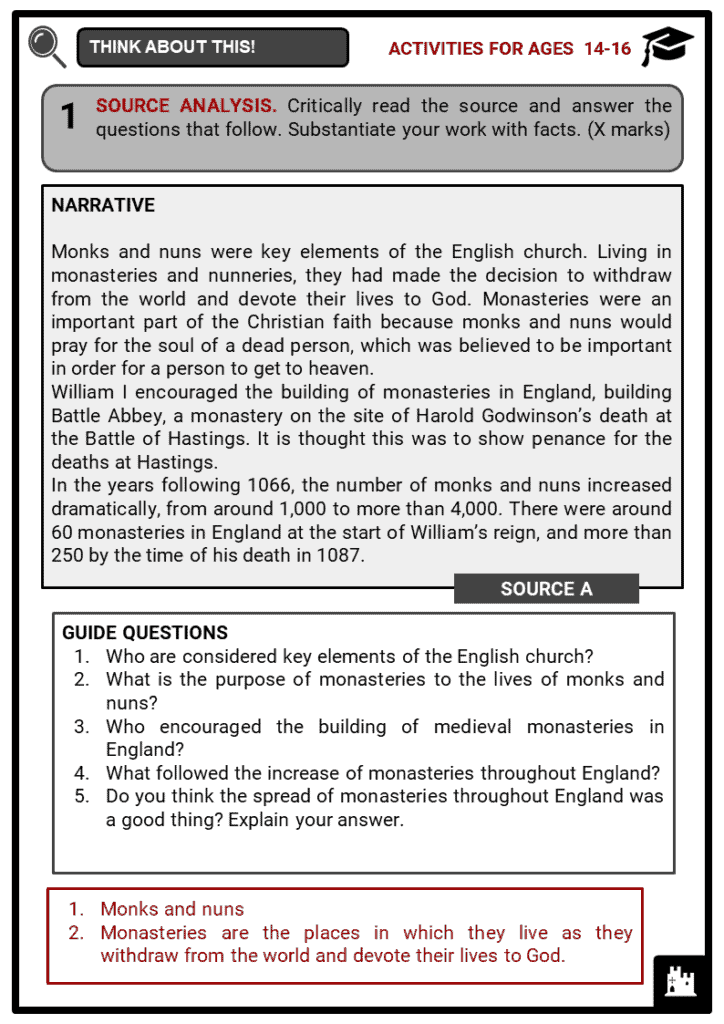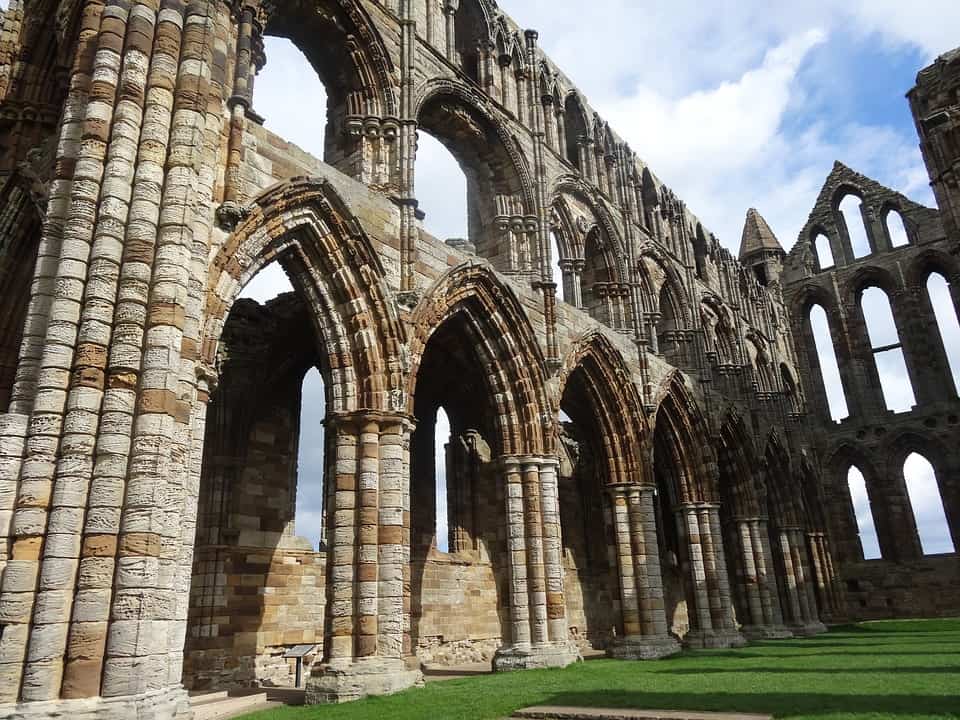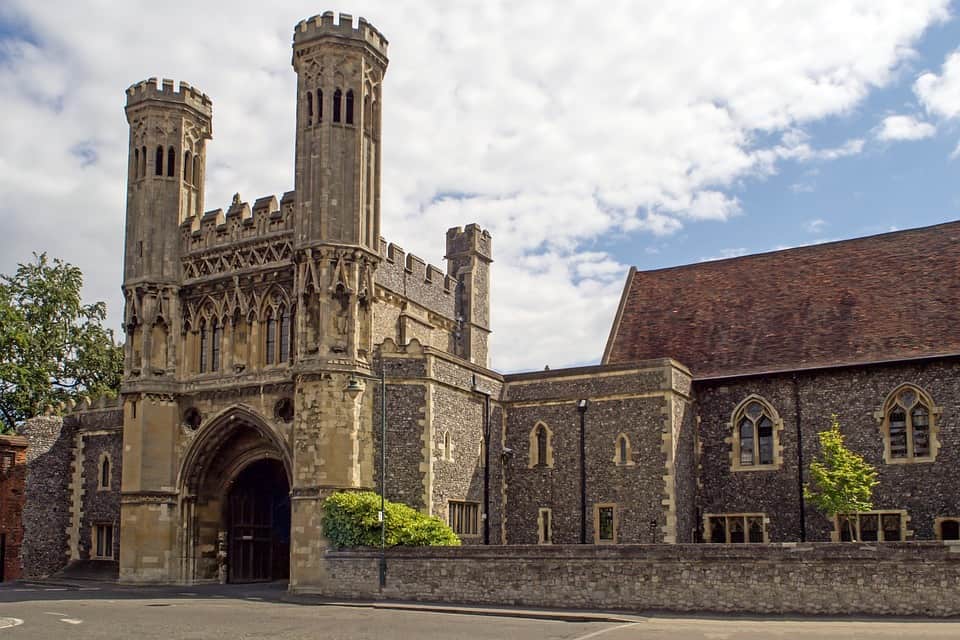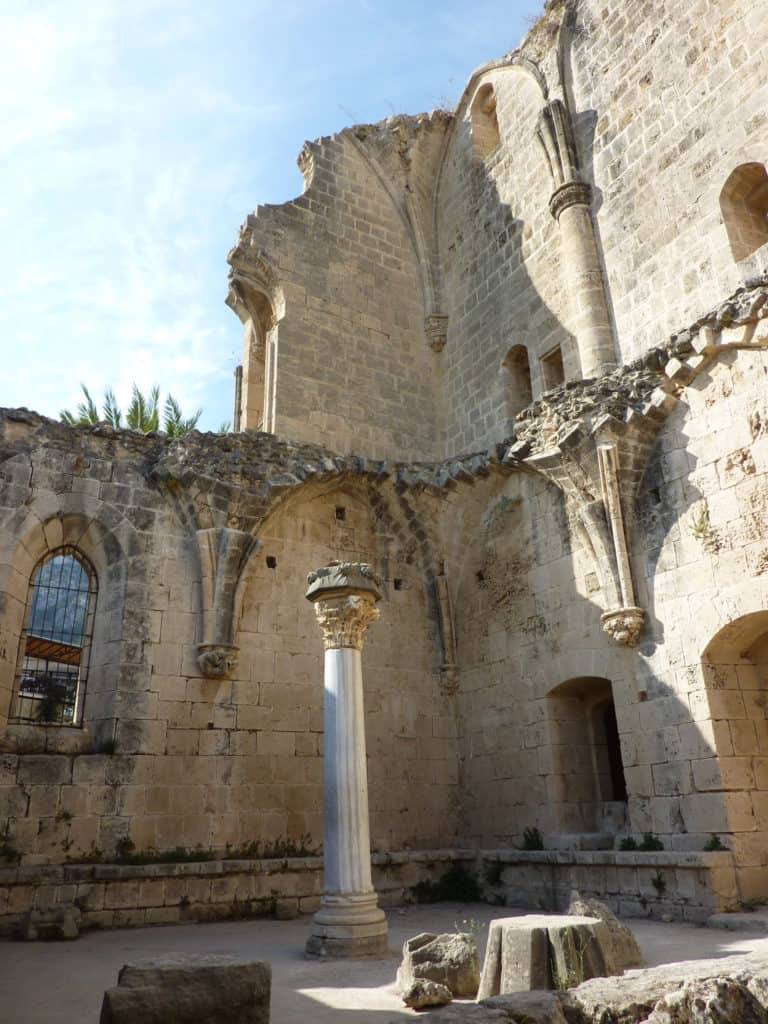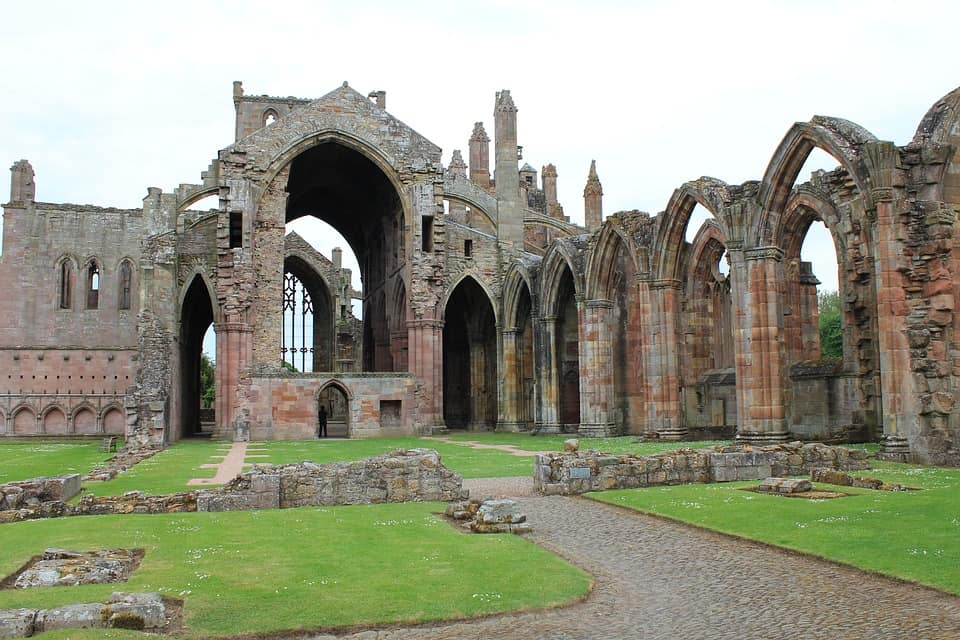Download Medieval Monasteries Worksheets
Do you want to save dozens of hours in time? Get your evenings and weekends back? Be able to teach Medieval Monasteries to your students?
Our worksheet bundle includes a fact file and printable worksheets and student activities. Perfect for both the classroom and homeschooling!
Table of Contents
Add a header to begin generating the table of contents
Summary
- The architecture of monasteries built in the Middle Ages
- Important structures within monasteries
- Monastic activities of monks and nuns
- Various social functions of a monastery in the Middle Ages
Key Facts And Information
Let’s find out more about Medieval Monasteries!
- A monastery is a complex of buildings where a religious community of monks or nuns lives. Such buildings originated in the Middle Ages. Monasteries exist in the Christian and Buddhist religions. If the monastery is led by an abbot, it is also referred to as an abbey, or a priory if it is of lesser importance. Often the priory is dependent on an abbey or a monastery. The monasteries of the military orders of the Middle Ages were called commanderies.
- The word ‘monastery’ derives from the Latin monastērĭum.
- Since the Middle Ages, a monastery is a building where a community of monks or nuns live under the authority of an abbot or an abbess. Monasteries do not constitute a religious order: each of them can be a separate community.
- Monasteries are not the same as convents. The latter was introduced with the advent of the mendicant orders, whose monks are called “friars” and “nuns”, i.e. brothers or sisters.
- Christian monasteries began to rise and grow after the age of persecution, although testimonies of common ascetic life are date from the earliest centuries of Christianity in the east.
- From an economic point of view, monasteries are self-sufficient. The spreading of monasteries throughout Europe is considered by many to be a decisive factor in the evangelisation of the continent, especially in some areas (for example, Ireland).
- Monks live a life of prayer and work. The work they carry out is oftenmanual. However, the type of job also depends on the era in which the monks live, as well as the geographical area of the monastery.
- Monasteries are also found in other religions.
- A particular type of monastery is an abbey, and it can be considered a religious community.
Architecture
- The breadth of monastic communities varied enormously in function, wealth and prestige: some were very small, others (though few) could also accommodate 900 monks. On average, however, they accommodated between 10 to 50, because the abbot had to know, follow and guide each of his monks.
- Usually built near a waterway, the whole monastic complex was oriented so that the water could be sent to the fountains and the kitchen, before reaching the laundry and the baths.
- The origins of the structure of the typical monastery remain obscure. Most likely, monks were inspired by Roman villas.
- A Roman villa was a country house for rich people built in the Roman Republic and the Roman Empire.
- Moreover, whenever they could, monks established their communities in pre-existing buildings. Often these buildings were ancient villas of Roman origin that were adapted.
- Sometimes they also occupied buildings previously dedicated to pagan cults.
- Over time, monasteries began to resemble each other as they started to be built following certain criteria. The end result was that a monastery resembled a small city. This was especially evident in big monasteries where houses were divided by streets and buildings.
- The church was the nucleus of the city and represented the religious centre of the community.
- Pursuing independence from the outside world, monks also equipped themselves with mills, ovens, stables, wineries and the craftsmen’s workshops where repairs and other needs of the community were met.
Church
- The church normally dominated the life of the abbey, and it was always very rich. Its size and richness also expressed the prosperity of the monastery. For the construction of buildings, monks were mainly inspired by Roman basilicas, which were widespread in Italy.
Cloister
- The cloister (from Latin claustrum, meaning closed place) is stylistically taken from the atrium of the Roman villa and is the place dedicated to meditation (for this reason, there existed the “rule of silence”).
- Arcades supported by columns and pillars always surround it and it was positioned in the centre of the various buildings of the monastery.
- It overlooked the most important buildings like the church, the chapter house for the meetings of the monastic community, the dormitory (then replaced by the cells), and the refectory. The cloister recalled the Hortus Conclusus (a medieval garden) and was charged with biblical-religious symbolism.
The Chapter House
- The chapter house is the place dedicated to the meetings of the monastic community where:
- People ask to be admitted to the monastery;
- The abbot offers a new name to the applicant who thus becomes a novice and, as a sign of humility and affection, washes his feet;
- The novice makes vows by becoming a monk;
- The abbot calls his monks and they consult on matters important to the community;
- It also serves as a chamber for deceased monks.
- Initially, the chapter house was only a place where the distribution of manual work among the monks would happen. Only with time it became a place dedicated exclusively to the official meetings of the community.
Library
- The libraries, particularly those of the Benedictine and Cistercian monasteries, carried out the very important function of preserving ancient knowledge after the fall of the Western Roman Empire.
- Monks dedicated themselves to the reading, studying and transcribing of texts that were gradually recovered from the ruins of the Roman Empire. The work of transcription was carried out in the scriptorium, a large room almost always linked to the library, which was equipped with large windows to facilitate the work of the Amanuensis monks.
- In the scriptoria, monks transcribed not only the texts of ancient civilisations but also the religious texts of the first Christian communities. They often embellished the texts with precious and richly decorated capital letters, details, annotations, and figures on the margins.
- Amanuensis monks are scribes who wrote the recitations of an author.
- Even today, the library of a monastery is very important, as reading and study are an integral part of monastic life. They are also open to and frequented by outside scholars.
Dorms and cells
- The dorm was the common dormitory where, according to the rule, a lamp was always kept on. If the dorm was full of monks, more lamps were placed in the dormitories. Over the years, common dormitories were replaced by individual cells.
Refectory
- The refectory was the common room where monks gathered to consume their meals.
- The tables were (and still are) normally arranged along three sides of the walls, leaving the centre free for the attendants.
- Near the refectory, there was always a common area equipped with a fountain, called the lavatorium or washroom, where one had to wash before and after meals.
- To make their time in the refectory a deeply religious act, a monk was instructed to read excerpts from the Sacred Scripture during the meal. Each week, different monks would work in the kitchen. In such a way, the function of cooking was shared.
Cemetery
- After their death, monks were buried in the cemetery inside the monastery. The honour of being buried among the monks was a privilege that the community would sometimes grant to bishops, kings and benefactors.
Garden of Simples
- This was a vegetable garden dedicated to the cultivation of herbs and medicinal plants, often placed near the infirmary. The word ‘simple’ comes from the Medieval Latin ‘medicamentum’ or ‘simplex medicine’, used to define medicinal herbs.
Kitchen
- The kitchen (where the monks served in weekly shifts) was located near the refectory. In larger monasteries, there were more kitchens for monks, novices and guests.
Toilets
- The toilets were separated from the main buildings and were reachable along a corridor. Monks took great care in hygiene and cleanliness and provided running water whenever possible.
Schools
- Many monasteries had external schools for novices and children (whose parents had destined them to monastic life). In recent years, some also established schools and colleges to those who do not have a religious calling.
Novitiate
- The novices, not yet part of the religious community, were not authorised to enter the cloistered area. They had a place in the choir during religious events but spent the rest of the time in the novitiate. An elderly monk, the prefect or master of the novices, instructed and supervised them in the principles of religious life. The probation period lasted a week. Older novitiates had their own dorms, kitchens, refectories, workrooms, and even cloisters.
Farm
- Farms were seen as an adequate job opportunity and a means of livelihood that ensured the security of the monastery food.
Warehouses and laboratories
- No monastery was complete without its dispensations to preserve food. There were also barrooms, wineries and other service venues. Moreover, many monasteries owned mills to grind grain.
Image sources:
[1.] https://cdn.pixabay.com/photo/2017/10/05/12/07/whitby-abbey-2819231_960_720.jpg
[2.] https://cdn.pixabay.com/photo/2016/08/17/10/03/st-augustines-abbey-1600021_960_720.jpg
[3.] https://upload.wikimedia.org/wikipedia/commons/6/66/Bellapais_Monastery_-_Chapter_house_%283%29.JPG
[4.] https://cdn.pixabay.com/photo/2017/05/30/12/00/melrose-abbey-2356735_960_720.jpg

